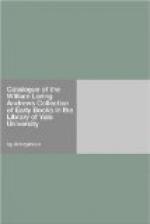Panzer was disposed to identify the peculiar roman type of these volumes with that used by the fourth printer of Venice, Clemente of Padua, between whom and Zarotto of Milan, Hain was later in doubt. But Proctor was convinced that the small group of books to which these belong, nearly all of them connected in some way with Florence, were the productions of the first, so far unidentified, press of that city. The date they bear (1471) places them among the earliest books printed in the Italian language. Witness the following first editions: Petrarch’s Canzoniere, 1470; Il Decamerone, 1471; La Divina Commedia, 1472.
The present copy, bound in blue morocco, with the crest of the Marquis of Blandford on side, was sold in his (White Knights) sale in 1819 for L2. Leaf 9-1/4 x 6-3/4 in.
From the Syston Park sale, December, 1884, with book-plate and the monogram (J.H.T.) of Sir John Hayford Thorold.
17. AESOPUS. Vita et fabulae graece.
Vita et fabulae latine. Fabulae
selectae graece et latine.
[Milan], Bonus Accursius, c. 1480.
Part I. Fol. 1^a: Bonus Accursius Pisanus doctissimo sapientissimo ducali quaestori Iohanni Francisco turriano salutem plurimam dicit. Fol. 2^a: [Greek: AISOPOU BIOS TOU MYTHOPOIOU MAXIMO TO PLANOUDE SYNGRAPHEIS]. Fol. 33^a: [Greek: AISOPOU MYTHOI]. Fol. 70^a: [Greek: Telos ton tou Aisopou Mython]. Part II. Fol. 1^a: Vita Aesopi fabulatoris clarissimi e graeco latina p_er_ Rynucium facta ad Reuere_n_dissimu_m_ Patre_m_ Dominu_m_ Antonium tituli Sancti Chrysogoni Presbyteru_m_ Cardinalem et primo prohoemium. Fol. 32^b: FINIS. Fol. 33^a: Argumentum fabula_rum_ Aesopi e graeco i_n_ latinu_m_. Fol. 59^b: Finis. Vita Aesopi per Rynucium thettalum traducta. Verum quoniam ab eo non nulla fueru_n_t praetetermissa (sic): fortassis q_ui_a graecus eius codex esset minus emendatus: Ego Bonus accursius Pisanus: eadem in ea omnia correxi; et emendaui. Fol. 60, blank. Part III. Fol. 1^a, blank. Fol. 1^b: Bonus Accursius Pisanus doctissimo ac sapientissimo ducali Quaestori Iohanni francisco Turriano salutem plurimam dicit. Fol. 2^a, col. 1: [Greek: MYTHOI AISOPOU], col. 2: Fabulae Aesopi. Fol. 38^a, col. 1: [Greek: TELOS TON TOU AISOPOU MYTHON]. Col. 2: FINIS AESOPI FABVLARVM. Bonus Accursius pisanus impressit: qui non doctorum hominum sed rudium ac puerorum gratia hunc laborem suscepit.
Quarto. Pt. I, sign. [A-H^8, I^6] not printed, but stamped irregularly on the extreme lower margin and partially cut away in the binding, 70 leaves. Pt. II, sign, a-g^8, and four unsigned leaves at the end, 60 leaves. Pt. III, sign. a-b^8, C-D^8, E^6, 38 leaves, the Greek text and the word-for-word Latin translation in two parallel columns. Both the Greek and the Latin have 25 lines to the page or column. Two- to five-line spaces for capitals,




